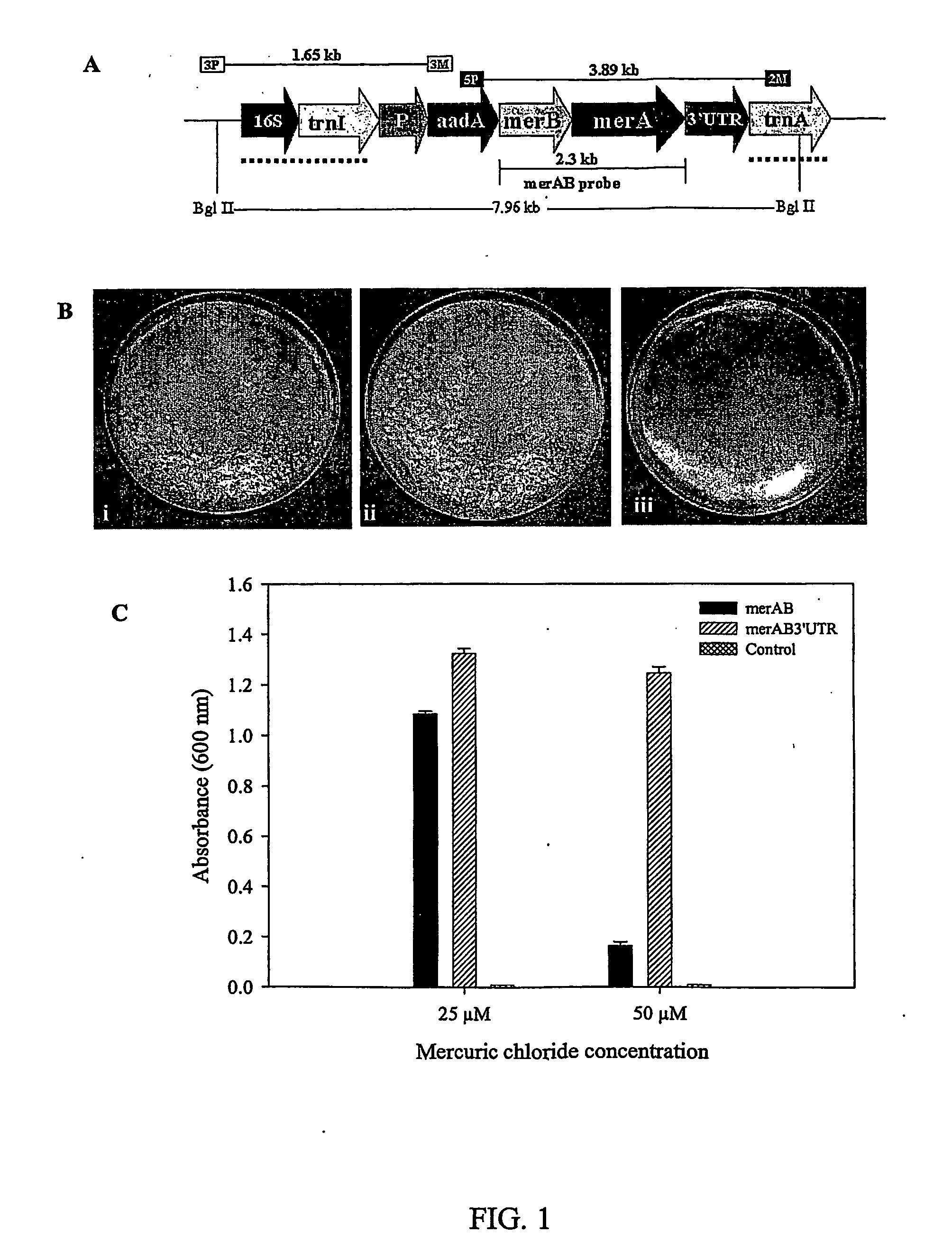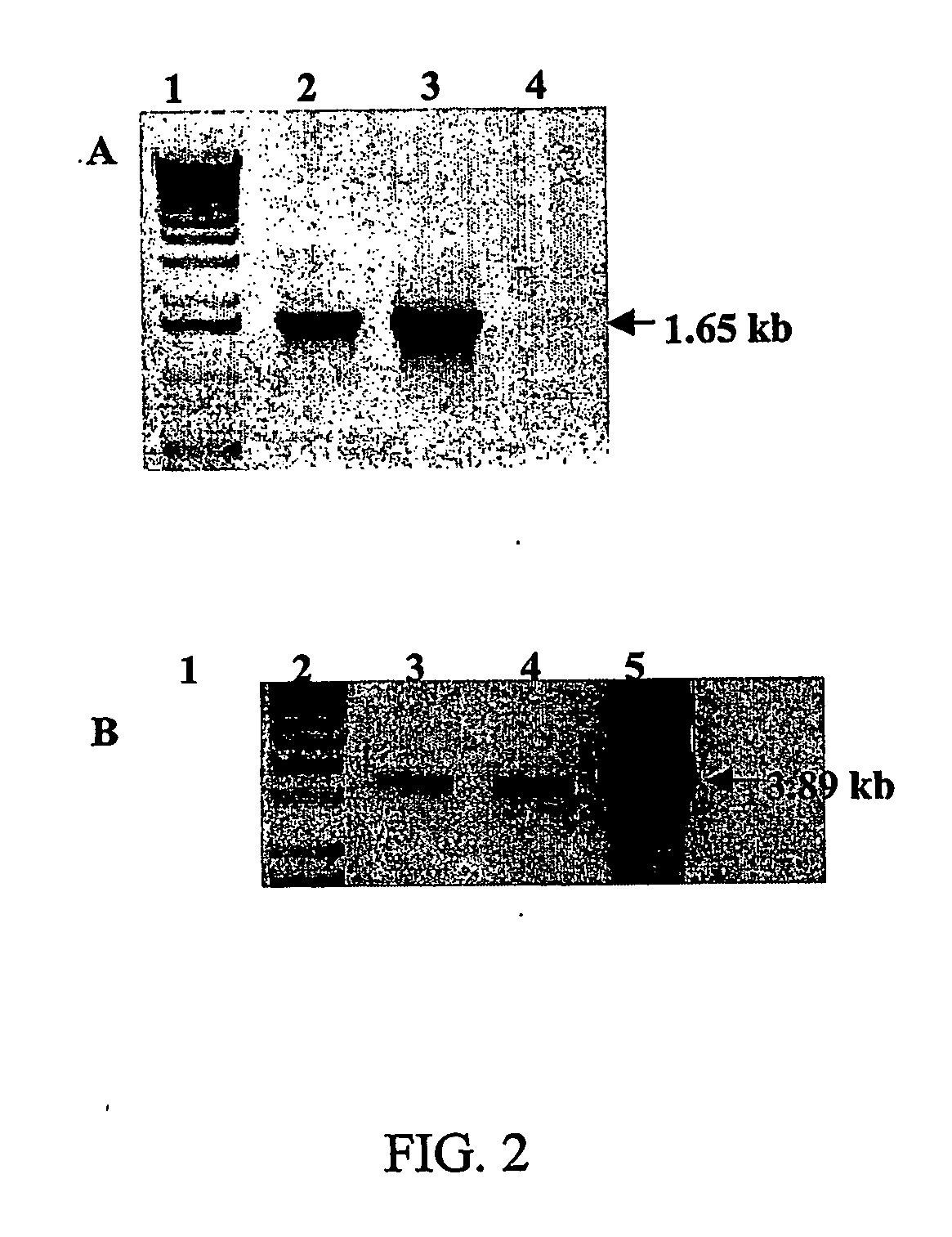Phytoremediation of contaminant compounds via chloroplast genetic engineering
a technology of plastid genome and contaminant, which is applied in the field of chloroplast genetic engineering, can solve the problems of large soil areas still polluted with toxic levels of trace elements, no one has achieved the effect of transforming the plastid genome to express contaminant reducing proteins, and insufficient contaminant removal rate using conventional plants and growth conditions, etc., to enhance the capacity of plants for phytoremediation and enhance the capacity of plants
- Summary
- Abstract
- Description
- Claims
- Application Information
AI Technical Summary
Problems solved by technology
Method used
Image
Examples
example 1
ILLUSTRATIVE EXAMPLE 1
[0333] Reference will now be made in detail to the presently preferred embodiments of the invention, which, together with the following example, serve to explain the principals of the invention. The following example is intended as a non-limiting example of the Applicants, and is no way to a intended as a limitation.
[0334] Mercury is a highly toxic element that is found both naturally or as an introduced contaminant in the environment (Patra and Sharma, 2000). It is usually found in the less toxic inorganic form which is extremely insoluble and chemically and physically stable (Gavis and Furgson 1972). Although the toxic effects of elemental mercury are low, the main problem is that elemental mercury can be converted to the highly toxic methylmercury through biological activities in soil and water (Nakamura et al., 1990, Meagher 2000), which may then be highly biomagnified up the food chain.
[0335] Traditional remediation strategies for mercury contaminated en...
example 2
ILLUSTRATIVE EXAMPLE 2
[0376] In Example 1, we successfully integrated, for the first time, both bacterial merA and mer B operon into the chloroplast genome of tobacco plant in a single transformation event. Such engineered plants provide important means of removing Hg from contaminated environments by metabolizing the toxic form of Hg (e.g. PMA) into less toxic and volatile Hg form (e.g. Hg [0]). The bacterial merB gene, encodes an organomercurial lyase, degrades MeHg to methane and Hg [II] while the bacterial merA gene, coding for the mercuric ion reductase (merA), converts ionic mercury (Hg [II]) to the volatilized elemental mercury (Hg [0]). The results of the transgenic lines showed that the plants expressing both genes were capable of tolerating up to 400 μM of organomercurials compounds when grown in soil.
[0377] Our previous results on the transgenic tobacco overexpressing the mer operon raised a number of questions of particular importance to their use in phytoremediation. Fo...
example 3
ILLUSTRATIVE EXAMPLE 3
[0419] The overall objective of this project is to engineer transgenic microalgae, a unicellular, photosynthetic aquatic plant, capable of the removal and degradation of explosive and nitroaromatic contaminants from contaminated water in bioreactor systems. The microalgae will also be engineered to sequester and detoxify heavy metals, common toxic copollutants of explosives. Fundamental and applied studies will be undertaken to characterize and develop microalgae as tools for phytoremediation. By the end of the project we aim to have pilot scale bioreactors available which contain microalgae expressing transgenes for the detoxification of nitrate ester, nitroaromatic and nitramine classes of explosives and the sequestration of heavy metals.
[0420] Background and Methodology
[0421] Example 3 incorporates all of the procedures, protocols and methods described in Examples 1 and 2.
[0422] Environmental contamination by explosives is a serious problem, as a vast amo...
PUM
| Property | Measurement | Unit |
|---|---|---|
| photosynthetic energy | aaaaa | aaaaa |
| chemical similarity | aaaaa | aaaaa |
| chemical properties | aaaaa | aaaaa |
Abstract
Description
Claims
Application Information
 Login to View More
Login to View More - R&D
- Intellectual Property
- Life Sciences
- Materials
- Tech Scout
- Unparalleled Data Quality
- Higher Quality Content
- 60% Fewer Hallucinations
Browse by: Latest US Patents, China's latest patents, Technical Efficacy Thesaurus, Application Domain, Technology Topic, Popular Technical Reports.
© 2025 PatSnap. All rights reserved.Legal|Privacy policy|Modern Slavery Act Transparency Statement|Sitemap|About US| Contact US: help@patsnap.com



